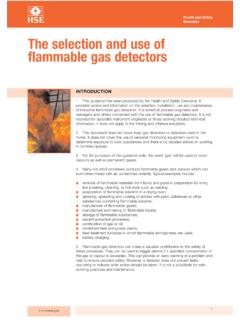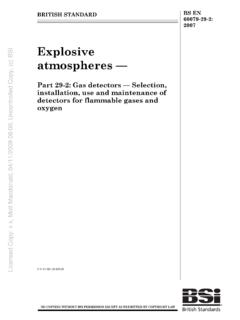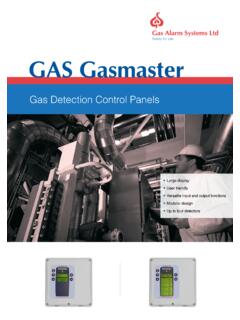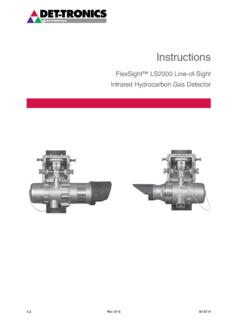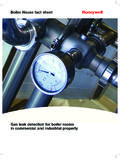Transcription of SECTION 4.0 ROTATING EQUIPMENT (DRIVEN ITEMS)
1 SECTION ROTATING EQUIPMENT (DRIVEN ITEMS) This SECTION of the guidance notes covers a selection of the ROTATING EQUIPMENT found on a typical offshore installation. These include : x Compressor Centrifugal (Barrel Type) SECTION x Compressor Screw ( Air Service ) SECTION x Compressor Screw ( Process ) SECTION x Compressor Reciprocating ( Process ) SECTION x Compressor Reciprocating ( Air Service ) SECTION x Pump Generic SECTION x Centrifugal Pump Large Single Stage SECTION x Centrifugal Pump Multistage SECTION x Centrifugal Pump Vertical Caisson SECTION x Centrifugal Pump HP Multistage SECTION x Centrifugal Pump Submersible SECTION x Centrifugal Pump High Speed SECTION x Pump Reciprocating, Plunger SECTION x Power Generating Set ( Alternator )
2 SECTION 4,0 1 4,0 2 SECTION CENTRIFUGAL GAS COMPRESSOR CONTENTS Centrifugal Gas Page 4,1 1 Page 4,1 2 Background & Page 4,1 3 Hazard Page 4,1 5 Operating Page 4,1 Maintenance Page 4,1 Centrifugal Gas Compressor Main Page 4,1 Integration Page 4,1 4,1 4,1 21 The target duty is the export of produced gas from a medium or large oil / gas field into a common manifold system. The back pressure in the manifold will vary depending on the total gas rate. The gas is a hydrocarbon mixture of variable molecular weight, including inert gases such as Nitrogen, and may contain corrosive/ toxic components such as Hydrogen Sulphide. Figure 4,1 1 Barrel Type Process Gas Compressor 4,1 1 INTRODUCTION x to use on the x x design x drive and x Gas Compressors are used to increase the pressure of a process gas, in order to drive it into a pipeline system to an onshore process plant, producing well as gas lift, to re-inject gas for reservoir pressure maintenance and for use as a fuel gas.
3 Turbo compressors are preferred for high mass flow systems because of their simplicity and reliability compared with screw or reciprocating compressors. In order to achieve the required pressure ratio, several compression stages may be required, in one or more casings. Each compression stage is carried out by a rotor in a matching diffuser. This document focuses on the single shaft multi-stage "Barrel" of compressor typically used for hydrocarbon gas compression in the oil & gas industry. Materials of construction must be mechanically capable, and compatible with process fluids anticipated throughout the field lifetime. Mechanically linked compressors, working together with support EQUIPMENT , may be regarded as a single system for design and safety purposes.
4 The major hazards relate to the inventory of flammable gas that can be released if there is an EQUIPMENT failure. Hazard assessment must relate to the complete package and not just the compressor body. The injury risk from a mechanical failure is relatively low, as the robust casing will retain parts. Hot / moving parts may still cause injury local to the machine. Most compressors have gas seals on moving drive shafts or piston rods. These are safety critical items when handling hazardous materials. It is often necessary to increase the pressure of a gas for processing, storage or transport reasons. There are two fundamentally different principles used to compress gases. Dynamic Compressors are continuous flow machines, they use ROTATING vanes or bladed discs to sequentially accelerate the gas (increasing its energy) then decelerate it (trading kinetic energy for increased pressure).
5 This normally requires a number of stages, often within the same casing. Dynamic compressors always have an open gas route through the machine. Positive Displacement Compressors are discontinuous flow machines, they induce a fixed volume of gas into a pocket, chamber or cylinder for compression. The size of this pocket is then reduced mechanically, compressing the gas. At the end of the compression cycle the pocket opens, discharging the high-pressure gas. Often only one or two stages of this compression process are required. There is never an open gas passage from delivery to suction (except for leakage through the clearances between moving parts. Dynamic (as opposed to Positive Displacement) compressors have relatively few moving parts, low vibration levels and thus high intrinsic reliability.)
6 Hence they are preferred over other compressor types where they can be used effectively. Compressor selection is a complex and subjective process, with similar duties resulting in quite dis-similar compressors choices. The materials of construction must be able to take the mechanical loads; in addition those parts in contact with the process gas must be chemically compatible. Non-metallic materials are often used in seals and valves. It is common practice, for dynamic compressors, to mount multiple compression stages on the same shaft within a common casing. For pressure ratios above perhaps 10 : 1, and for 4,1 2 discharge pressures above perhaps 20 barg, a Barrel Type Multistage Centrifugal Compressor would be a reasonable selection. Where a high-pressure ratio is required, different sizes of compressor, running at different speeds, may be linked to a single common driver.
7 Gearbox(es) match the various shaft speeds. To achieve reasonably practical shaft alignment and permit thermal expansion, flexible couplings are used between co-axial shafts. Compressors require robust base-plates to carry shaft torques and piping loads without excessive distortion. This is particularly true offshore with the baseplate having to provide the necessary stiffness for alignment and dynamic stability on the offshore installation where the structure itself is too mobile. Compressors require suitable piping, interstage vessels and coolers with associated control systems. Together with baseplate and driver this forms the "Compressor System". The vast majority of compressors are shaft driven by a separate electric motor, gas turbine or diesel engine.
8 Thus the compressor will require at least one shaft seal, which may have to contain hazardous gas. The safety of compressors handling hazardous materials is dominated by their shaft sealing systems. These require appropriate design, maintenance and operator attention. BACKGROUND & HISTORY x x x x Most early gas compressors were of reciprocating design; more recently even high-pressure applications can be met with high-speed multi stage centrifugal compressors. "Barrel" casing design is preferred for high-pressure hazardous applications. Other designs of compressor may be selected according to process duty and designer / user preference. Typical modern process compressors have shaft speeds in the range 5000 - 10000 rev/minute and are tailor made to the required duty.
9 Gas compressors have been in use for well over a hundred years, turbo compressor development however has really only been in the second half of the twentieth century, using improved design and manufacturing methods. Early compressor design had a pressure casing with a horizontal split along the shaft, a split internal stator arrangement and up to about 9 stages on a single rotor shaft. For high pressures, several casings are operated in series, often at different shaft speeds. As system pressures have risen, it has become more and more difficult to build compressors with a reliable horizontal split joint. This is particularly so as discharge temperatures can exceed 200 C. 4,1 3 Recent design of high pressure compressors has favoured "barrel" casing design, where the pressure containment is a single cylindrical housing with end caps, containing a stator and rotor "cartridge".
10 The end caps are often retained with a locking ring system and sealed with "O" rings, this being a much more secure and easily operated system than a long bolted joint. The cartridge is built up and loaded into the barrel, in this way a new cartridge can be fitted relatively quickly. Bearings and seals are built into the end caps. Screw compressors may be used for lower capacity systems. Screws are a relatively recent design due to the very sophisticated manufacturing required. Screw Compressor Principle The type of multi-stage turbo compressor referred to as a "Bullgear" machine consists of several single stage compressors driven by an integral gearbox. The design lends itself to efficient compression, due to use of intercooling.










